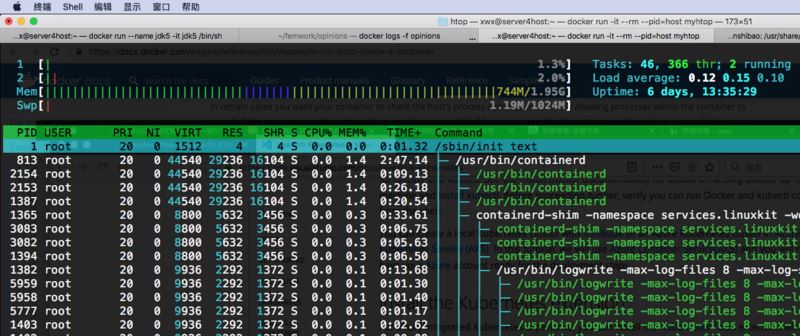Docker 运行时的用户与组管理 Docker 运行时的用户与组管理的方法
Yujiaao 人气:3docker 以进程为核心, 对系统资源进行隔离使用的管理工具. 隔离是通过 cgroups (control groups 进程控制组) 这个操作系统内核特性来实现的. 包括用户的参数限制、 帐户管理、 资源(CPU,内存,磁盘I/O,网络)使用的隔离等. docker 在运行时可以为容器内进程指定用户和组. 没有指定时默认是 root .但因为隔离的原因, 并不会因此丧失安全性. 传统上, 特定的应用都以特定的用户来运行, 在容器内进程指定运行程序的所属用户或组并不需要在 host 中事先创建.
进程控制组cgroups主要可能做以下几件事:
- 资源限制 组可以设置为不超过配置的内存限制, 其中还包括文件系统缓存
- 优先级 某些组可能会获得更大的 CPU 利用率份额或磁盘 i/o 吞吐量
- 帐号会计 度量组的资源使用情况, 例如, 用于计费的目的
- 控制 冻结组进程, 设置进程的检查点和重新启动
与 cgroups(控制进程组) 相关联的概念是 namespaces (命令空间).
命名空间主要有六种名称隔离类型:
- PID 命名空间为进程标识符 (PIDs) 的分配、进程列表及其详细信息提供了隔离。
虽然新命名空间与其他同级对象隔离, 但其 "父 " 命名空间中的进程仍会看到子命名空间中的所有进程 (尽管具有不同的 PID 编号)。
- 网络命名空间隔离网络接口控制器 (物理或虚拟)、iptables 防火墙规则、路由表等。网络命名空间可以使用 "veth " 虚拟以太网设备彼此连接。
- UTS 命名空间允许更改主机名。
- mount(装载)命名空间允许创建不同的文件系统布局, 或使某些装入点为只读。
- IPC 命名空间将 System V 的进程间通信通过命名空间隔离开来。
- 用户命名空间将用户 id 通过命名空间隔离开来。
普通用户 docker run 容器内 root
如 busybox, 可以在 docker 容器中以 root 身份运行软件. 但 docker 容器本身仍以普通用户执行.
考虑这样的情况
echo test | docker run -i busybox cat
前面的是当前用户当前系统进程,后面的转入容器内用户和容器内进程运行.
当在容器内 PID 以1运行时, Linux 会忽略信号系统的默认行为, 进程收到 SIGINT 或 SIGTERM 信号时不会退出, 除非你的进程为此编码. 可以通过 Dockerfile STOPSIGNAL signal指定停止信号.
如:
STOPSIGNAL SIGKILL
创建一个 Dockerfile
FROM alpine:latest RUN apk add --update htop && rm -rf /var/cache/apk/* CMD ["htop"]
$ docker build -t myhtop . #构建镜像 $ docker run -it --rm --pid=host myhtop #与 host 进程运行于同一个命名空间

普通用户 docker run 容器内指定不同用户 demo_user
docker run --user=demo_user:group1 --group-add group2 <image_name> <command>
这里的 demo_user 和 group1(主组), group2(副组) 不是主机的用户和组, 而是创建容器镜像时创建的.
当Dockerfile里没有通过USER指令指定运行用户时, 容器会以 root 用户运行进程.
docker 指定用户的方式
Dockerfile 中指定用户运行特定的命令
USER <user>[:<group>] #或 USER <UID>[:<GID>]
docker run -u(--user)[user:group] 或 --group-add 参数方式
$ docker run busybox cat /etc/passwd root:x:0:0:root:/root:/bin/sh ... www-data:x:33:33:www-data:/var/www:/bin/false nobody:x:65534:65534:nobody:/home:/bin/false $ docker run --user www-data busybox id uid=33(www-data) gid=33(www-data)
docker 容器内用户的权限
对比以下情况, host 中普通用户创建的文件, 到 docker 容器下映射成了 root 用户属主:
$ mkdir test && touch test/a.txt && cd test $ docker run --rm -it -v `pwd`:/mnt -w /mnt busybox /bin/sh -c 'ls -al /mnt/*' -rw-r--r-- 1 root root 0 Oct 22 15:36 /mnt/a.txt
而在容器内卷目录中创建的文件, 则对应 host 当前执行 docker 的用户:
$ docker run --rm -it -v `pwd`:/mnt -w /mnt busybox /bin/sh -c 'touch b.txt' $ ls -al -rw-r--r-- 1 xwx staff 0 10 22 23:36 a.txt -rw-r--r-- 1 xwx staff 0 10 22 23:54 b.txt
docker volume 文件访问权限
创建和使用卷, docker 不支持相对路径的挂载点, 多个容器可以同时使用同一个卷.
$ docker volume create hello #创建卷 hello $ docker run -it --rm -v hello:/world -w /world busybox /bin/sh -c 'touch /world/a.txt && ls -al' #容器内建个文件 total 8 drwxr-xr-x 2 root root 4096 Oct 22 16:38 . drwxr-xr-x 1 root root 4096 Oct 22 16:38 .. -rw-r--r-- 1 root root 0 Oct 22 16:38 a.txt $ docker run -it --rm -v hello:/world -w /world busybox /bin/sh -c 'rm /world/a.txt && ls -al' #从容器内删除 total 8 drwxr-xr-x 2 root root 4096 Oct 22 16:38 . drwxr-xr-x 1 root root 4096 Oct 22 16:38 ..
外部创建文件, 容器内指定用户去删除
$ touch c.txt && sudo chmod root:wheel c.txt $ docker run -u 100 -it --rm -v `pwd`:/world -w /world busybox /bin/sh -c 'rm /world/c.txt && ls -al'
实际是可以删除的
rm: remove '/world/c.txt'? y total 4 drwxr-xr-x 4 100 root 128 Oct 23 16:09 . drwxr-xr-x 1 root root 4096 Oct 23 16:09 .. -rw-r--r-- 1 100 root 0 Oct 22 15:36 a.txt -rw-r--r-- 1 100 root 0 Oct 22 15:54 b.txt
docker 普通用户的1024以下端口权限
$ docker run -u 100 -it --rm -p 70:80 busybox /bin/sh -c 'nc -l -p 80' nc: bind: Permission denied #用户id 100 时, 不能打开80端口 $ docker run -u 100 -it --rm -p 70:8800 busybox /bin/sh -c 'nc -l -p 8800' #容器端口大于1024时则可以 ... $ docker run -it --rm -p 70:80 busybox /bin/sh -c 'nc -l -p 80' #容器内是 root 也可以 ...
加载全部内容